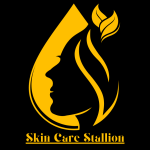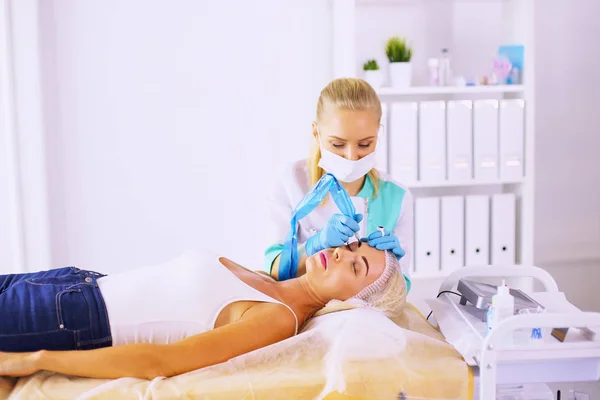The minor complications normally experienced because of Hydrafacial Side Effects In summer are redness of the skin, slight peeling, and abnormal sensitivity to sunlight because of heat.
Since HydraFacial treatment aim at making skin appear anew, such treatments are more sought after especially during summer. Nonetheless, let it be burning skin, welts, or redness: everyone should know there are certain reactions that one may face after having the treatment in summer or even in the hot weather.
HydraFacial side effects can range from skin sensitivity to erythema or one’s face being red and irritated for weeks, disrupting your summer.
It is thus important to understand all the possible reactions that could occur to the skin as a result of cold weather and how to avoid this so that the skin continues to remain healthy, glowing and protected all through the season.
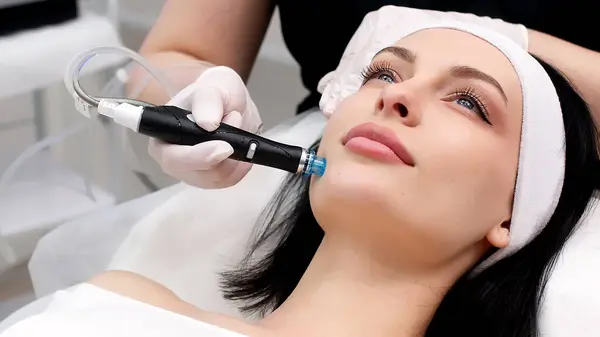
Hydrafacial Side Effects In Summer
Hydrafacials are popular for their deep hydration and rejuvenation. However, summer heat may make other facial treatments more suitable. Here’s a guide to summer-friendly alternatives with fewer side effects:
Microneedling (with Caution)
Microneedling uses tiny needles to stimulate collagen production. It can improve skin texture and reduce fine lines. However, in summer, sun exposure can increase the risk of hyperpigmentation. Use sun protection and avoid direct sunlight for best results.
Gentle Enzyme Peels
Enzyme peels exfoliate the skin using natural fruit enzymes. They are milder than chemical peels and reduce the risk of irritation. Ideal for summer, they enhance skin brightness and smoothness without aggressive peeling.
Oxygen Facials
Oxygen facials deliver pure oxygen and nutrients to the skin. They help with hydration and revitalization, providing a fresh glow. This treatment is gentle and suitable for all skin types, including sensitive skin.
Benefits and Potential Side Effects
Microneedling
Benefits include improved texture and reduced wrinkles. Side effects might be redness and sensitivity.
Enzyme Peels
Benefits are gentle exfoliation and enhanced radiance. Side effects are minimal but may include slight redness.
Oxygen Facials
Benefits include deep hydration and a youthful glow. Side effects are rare but can include mild redness.
These alternatives offer effective results with fewer side effects compared to Hydrafacials. Always consult a skincare professional to choose the best treatment for your skin type and summer conditions.
What is a Hydrafacial?
A Hydrafacial is a non-invasive skincare treatment that cleanses, exfoliates, extracts impurities, hydrates, and protects the skin. It combines hydradermabrasion with nourishing serums to rejuvenate the skin. This advanced facial treatment is popular for its immediate, noticeable results and minimal downtime.
Explanation of the Hydrafacial Procedure
The Hydrafacial procedure uses a multi-step approach to achieve healthy, glowing skin. It involves cleansing, exfoliating, extracting impurities, and delivering intense hydration. A specialized device with a vortex-fusion technology gently removes dead skin cells and dirt while infusing the skin with hydrating serums. This treatment is suitable for all skin types and addresses various concerns, such as fine lines, acne, and dullness.
Steps of a Hydrafacial
Cleansing
The process begins with deep cleansing. A gentle cleansing solution is applied to remove surface dirt, oil, and makeup. This step prepares the skin for the following treatments.
Exfoliation
Exfoliation removes dead skin cells that can clog pores and dull the complexion. A mild glycolic or salicylic acid solution is used to resurface the skin, promoting cell turnover and revealing fresh, new skin underneath.
Extraction
Unlike traditional facials that use manual extraction, Hydrafacials use a painless suction technique. This step removes blackheads, whiteheads, and impurities from the pores without causing discomfort or redness.
Hydration
This step infuses the skin with hydrating serums rich in antioxidants, peptides, and hyaluronic acid. The serums are tailored to specific skin needs, such as hydration, brightening, or anti-aging.
Protection
The final step involves applying a nourishing serum that locks in moisture and protects the skin from environmental damage. It helps maintain the skin’s freshness and glow.
Benefits of Hydrafacials for Skin Health
Hydrafacials offer numerous benefits for overall skin health. They provide deep hydration, reduce fine lines and wrinkles, improve skin texture and tone, and unclog pores.
This treatment also reduces acne breakouts, minimizes hyperpigmentation, and promotes a radiant complexion. The gentle nature of Hydrafacials makes them suitable for sensitive skin. There is no downtime, allowing people to return to their daily activities immediately after the session.
How Hydrafacial Differs from Other Facial Treatments
Hydrafacial is distinct from other facial treatments due to its patented vortex-fusion technology. While traditional facials often involve manual extraction and exfoliation, Hydrafacials use a vacuum-powered extraction method that is painless and effective.
Unlike chemical peels and microdermabrasion, Hydrafacials are gentle on the skin and do not cause irritation. The customizable nature of Hydrafacial treatments allows for tailored solutions based on specific skin concerns. This makes Hydrafacials a preferred choice for many looking for immediate results without harsh side effects.
Why Hydrafacials Are Popular in Summer
Hydrafacials are a go-to skincare treatment in summer. They offer deep hydration, making them ideal for hot weather. This non-invasive facial cleanses, exfoliates, and hydrates the skin. It suits most skin types and provides quick, noticeable results without any downtime.
Hydration Benefits During Hot Weather
Hydrafacials provide essential hydration when the skin needs it most. The hot summer sun can strip the skin of moisture, leading to dehydration and dullness. Hydrafacials infuse the skin with serums that restore hydration.
This keeps the skin plump, refreshed, and glowing all summer long. The hydration boost helps maintain a healthy skin barrier, crucial for protecting against UV damage and pollutants.
Combats Summer Skin Issues
Summer brings challenges like oiliness, clogged pores, and dehydration. Hydrafacials target these common issues effectively. They use a unique vortex suction to clear out clogged pores, removing dirt, oil, and impurities.
This deep cleansing helps reduce blackheads and breakouts. The treatment also balances oil production, which is essential for those with oily or combination skin in humid weather.
Safe for All Skin Types with Quick Results
Hydrafacials are gentle and suitable for all skin types, including sensitive skin. They do not cause irritation or redness, making them perfect for summer when skin is more reactive.
The treatment offers immediate results. Skin looks clearer, more radiant, and well-hydrated right after the session. With no downtime, it’s easy to fit a Hydrafacial into a busy summer schedule.
No Downtime, Only Benefits
Hydrafacials are popular because they deliver maximum benefits with minimal effort. There’s no need for recovery time. You can go back to your daily activities immediately after the treatment. This makes it an ideal choice for those who want glowing skin without any hassle or extended recovery.
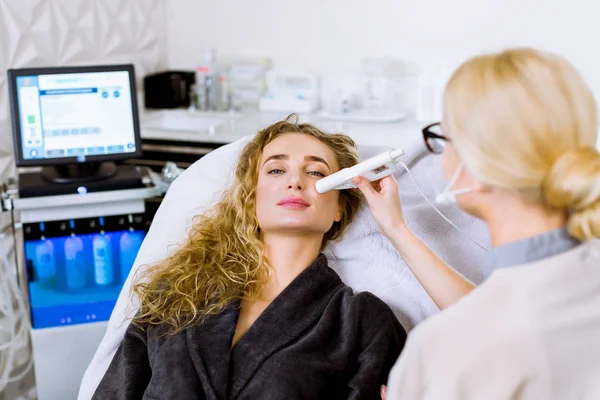
Common Side Effects of Hydrafacial in Summer
HydraFacial treatments are popular for achieving glowing, rejuvenated skin. However, like any skincare procedure, they come with potential side effects. These effects may be more noticeable in the summer due to the sun, heat, and environmental changes. Understanding these side effects can help manage expectations and plan accordingly.
Temporary Redness
Temporary redness is a common side effect of HydraFacial. After the treatment, the skin may appear flushed or red. This happens because the procedure deeply cleanses and exfoliates the skin.
In summer, the skin is more sensitive due to increased sun exposure. UV rays can intensify redness, making it more visible and lasting longer. To minimize this, use a soothing moisturizer and avoid direct sunlight.
Slight Peeling or Flaking
Peeling or flaking is another possible side effect. The HydraFacial process removes dead skin cells, which can lead to slight peeling or dryness afterward.
This is generally mild but can be more pronounced in summer. Hot weather can dehydrate the skin, worsening peeling. Hydrate your skin by drinking plenty of water and using a hydrating serum. Opt for a gentle moisturizer to calm and nourish the skin.
Minor Swelling
Minor swelling is also a potential side effect of HydraFacial. The skin may swell slightly due to deep cleansing and extraction. In summer, heat can cause the skin to swell more easily.
Combined with the treatment, this may lead to more noticeable puffiness. Cooling gels or ice packs can help reduce swelling. Avoid heavy makeup immediately after treatment to allow the skin to breathe and heal.
Sensitivity to Sunlight
Increased sensitivity to sunlight is a key concern after a HydraFacial. The skin’s barrier is temporarily weakened, making it more susceptible to UV damage.
In summer, this risk is higher due to more intense sunlight. Sunburns and hyperpigmentation can occur if proper care is not taken. Always apply broad-spectrum sunscreen with a high SPF. Reapply every two hours, especially if sweating or swimming.
Reasons Why Side Effects May Be More Pronounced in Summer
Summer conditions can amplify HydraFacial side effects. High temperatures, sun exposure, and increased humidity can affect the skin’s healing process. The skin tends to be more reactive and sensitive in the heat. UV rays can worsen redness, peeling, and swelling.
Proper aftercare is crucial, including sun protection, hydration, and gentle skincare products. Avoiding the midday sun and wearing protective clothing can also help manage these side effects effectively.
Skin Sensitivity and Sun Exposure
Hydrafacial treatments are popular for rejuvenating and hydrating the skin. However, they can leave the skin more sensitive to external factors. Increased skin sensitivity after a Hydrafacial is common, making the skin prone to sunburn or sun damage.
This heightened sensitivity occurs because Hydrafacial exfoliates and cleanses the skin deeply, removing dead skin cells and revealing a fresh layer. This new skin is more vulnerable to UV rays and environmental stressors.
Increased Sensitivity Post-Hydrafacial
A Hydrafacial involves deep cleansing, exfoliation, extraction, hydration, and infusion of serums. This intensive treatment can increase skin sensitivity, particularly to the sun. Right after a Hydrafacial, your skin might feel softer and look brighter. However, it is also more exposed and sensitive.
The removal of the outermost layer of skin can temporarily weaken the skin barrier. This can make your skin more susceptible to sunburn, irritation, or dryness. This is why post-Hydrafacial care is crucial to maintaining results and avoiding adverse effects.
Risks of Sunburn or Sun Damage Post-Treatment
Sun exposure after a Hydrafacial can lead to severe sunburn or long-term skin damage. Since the treatment involves exfoliating the skin, the fresh skin cells are exposed and more delicate. This delicate skin can easily get sunburned even with minimal sun exposure.
Without proper protection, UV rays can penetrate deeper, causing hyperpigmentation, premature aging, or worse, increasing the risk of skin cancer. The sun’s harmful rays can quickly undo the benefits of the Hydrafacial, making the skin red, inflamed, and even causing peeling.
Importance of Sun Protection Immediately After a Hydrafacial
Sun protection is vital immediately after a Hydrafacial. Dermatologists recommend using broad-spectrum sunscreen with at least SPF 30 to shield the skin from UVA and UVB rays. It is also advisable to wear a wide-brimmed hat and seek shade when outdoors.
Avoiding direct sunlight, especially during peak hours, can help prevent potential damage. Reapplying sunscreen every two hours is essential to ensure continuous protection.
Protective measures help maintain the results of the Hydrafacial and keep the skin healthy and glowing. Hydrated skin benefits significantly from minimal sun exposure, and adequate protection keeps it in optimal condition.
Risk of Hyperpigmentation
Hyperpigmentation is a common skin concern that affects people of all skin tones. It occurs when certain areas of the skin darken due to an overproduction of melanin. UV exposure, skin trauma, and certain cosmetic treatments can increase this risk. Understanding how to prevent hyperpigmentation is key to maintaining even skin tone and texture.
How UV Exposure Can Lead to Post-Inflammatory Hyperpigmentation
UV exposure is a leading cause of post-inflammatory hyperpigmentation (PIH). When the skin is exposed to UV rays, it stimulates melanin production. For individuals prone to PIH, any skin injury or inflammation can trigger dark spots or patches.
The sun’s UV rays can worsen these spots, making them more pronounced and harder to fade. Using broad-spectrum sunscreen daily can help protect the skin from UV damage and reduce the risk of pigmentation.
Why Individuals with Darker Skin Tones May Be More Prone to Pigmentation Issues After a Hydrafacial
Hydrafacial treatments involve deep exfoliation and can cause minor skin irritation. For individuals with darker skin tones, this irritation can lead to hyperpigmentation. Darker skin has more melanin, making it more reactive to trauma or inflammation.
After a Hydrafacial, the skin is more sensitive to sunlight and environmental factors. This sensitivity increases the likelihood of pigmentation problems. It is crucial for individuals with darker skin to follow proper aftercare and sun protection to prevent hyperpigmentation.
Preventive Measures to Reduce Risk
Preventing hyperpigmentation involves a combination of protective measures and skincare practices. Here are key steps to minimize risk:
Use Sunscreen Daily
Apply a broad-spectrum SPF of 30 or higher every day. Sunscreen protects the skin from harmful UV rays that can worsen pigmentation.
Avoid Peak Sun Hours
Stay indoors during peak sun hours, typically from 10 a.m. to 4 p.m. If you need to be outside, wear protective clothing and a wide-brimmed hat.
Post-Treatment Skincare
After a Hydrafacial or any cosmetic procedure, follow your dermatologist’s aftercare advice. This includes avoiding sun exposure, using gentle skincare products, and keeping the skin hydrated.
Antioxidant Serums
Use serums with ingredients like vitamin C and niacinamide. These antioxidants help reduce the appearance of dark spots and even out skin tone.
By understanding the risks and taking proactive steps, individuals can minimize the risk of hyperpigmentation and maintain a clear, even complexion.
Potential for Increased Oil Production and Breakouts
Hot and humid summer weather can significantly impact skin health. During warmer months, the skin’s sebaceous glands tend to produce more oil. This increased oil production, or sebum, can clog pores and lead to acne and breakouts.
The problem is even more pronounced post-Hydrafacial treatments, where the skin is deeply cleansed and exfoliated. Managing oil production is crucial to maintaining clear, healthy skin during summer.
How Summer Weather Affects Oil Production
Hot and humid conditions cause the skin to sweat more. This sweating triggers the sebaceous glands to produce more oil. Excessive sebum mixes with sweat, dirt, and bacteria on the skin’s surface.
This combination clogs pores, resulting in blackheads, whiteheads, and acne. People with oily skin types are especially prone to this issue in summer. Hence, understanding how weather affects your skin’s oil balance is key to managing breakouts.
Breakouts After Hydrafacial: The Cause
Hydrafacial treatments cleanse and exfoliate the skin, removing dirt, oil, and dead skin cells. However, post-Hydrafacial, the skin might still produce excess sebum, especially in hot weather. This excessive oil production can counteract the treatment’s benefits, leading to acne and breakouts. Hydrafacial treatments also temporarily open pores, making them more susceptible to getting clogged with sebum and sweat. For people with oily or combination skin, this can lead to unwanted breakouts.
Tips for Managing Oil Production Post-Hydrafacial
Use a Lightweight, Oil-Free Moisturizer
Hydrate the skin without adding extra oil. Look for non-comedogenic products that won’t clog pores.
Apply a Mattifying Sunscreen
Protect your skin from UV damage while controlling shine. Choose a broad-spectrum, oil-free sunscreen to avoid breakouts.
Keep the Skin Clean
Use a gentle, oil control cleanser twice a day. Cleansing helps remove excess oil and prevents pore blockage.
Incorporate Salicylic Acid or Benzoyl Peroxide
These ingredients help control oil and target acne causing bacteria. They are effective in preventing and treating breakouts.
Avoid Touching Your Face
Touching transfers bacteria and oil from your hands to your face. This can worsen post-Hydrafacial breakouts.
Use Blotting Papers Throughout the Day
They help absorb excess oil without disturbing your skincare routine. This simple step keeps your skin fresh and clean.
Managing oil production post Hydrafacial requires a consistent skincare routine. Adapting your regimen to the summer weather can prevent breakouts and maintain your skin’s clarity. Remember, proper aftercare is essential for maximizing the benefits of a Hydrafacial treatment.
Dryness and Dehydration
Effects of Hot, Dry Weather on Skin Hydration Levels
Hot, dry weather can severely impact skin hydration levels. When humidity is low, moisture evaporates quickly from the skin, leading to dehydration.
This results in dryness, tightness, and flakiness. Prolonged exposure to dry conditions can compromise the skin barrier, causing redness, irritation, and an increased risk of fine lines and wrinkles. To combat this, it’s essential to use hydrating skincare products.
Look for ingredients like hyaluronic acid, glycerin, and ceramides. These ingredients help lock in moisture, restore the skin barrier, and prevent dehydration.
How Hydrafacial Can Sometimes Lead to Temporary Dryness or Peeling
A Hydrafacial is a popular treatment for deep cleansing and hydration. However, it can sometimes cause temporary dryness or peeling. The procedure involves exfoliation and extraction, which can strip away natural oils. This may leave the skin feeling dry or sensitive immediately after the session.
Some people may notice slight peeling as the skin renews itself. This is normal and should resolve within a few days. It’s crucial to follow the recommended aftercare routine. Using a gentle moisturizer and avoiding harsh products can help the skin recover faster.
Importance of Post-Care Hydration and Moisturizing
Post-care hydration is vital after any skincare treatment, especially after a Hydrafacial. Rehydrating the skin helps maintain results and prevents dryness. Use a rich, hydrating moisturizer that supports the skin barrier. Ingredients like aloe vera, niacinamide, and peptides can soothe and repair the skin.
Drinking plenty of water is also essential for internal hydration. Avoiding sun exposure and using a broad-spectrum sunscreen will further protect your skin. A well-rounded skincare routine ensures skin stays healthy, hydrated, and glowing after treatments.
Irritation from Chlorine and Saltwater Exposure
How Chlorine and Saltwater Affect Freshly Treated Skin
Chlorine and saltwater can irritate freshly treated skin, especially after procedures like a Hydrafacial. Chlorine, found in swimming pools, can strip the skin of natural oils, causing dryness and irritation.
The chemicals in chlorine can also cause redness and sensitivity, especially on newly exfoliated skin. Saltwater from the ocean can be abrasive, dehydrating the skin and worsening sensitivity. Freshly treated skin is more vulnerable to these elements, leading to discomfort and potential adverse reactions.
Guidelines for Swimming After a Hydrafacial
Avoid swimming in chlorine pools or saltwater for at least 48 hours after a Hydrafacial. The skin needs time to heal and recover its barrier function. Chlorine and salt can disrupt the skin’s protective layer, causing stinging, dryness, and irritation.
If swimming is unavoidable, apply a barrier cream or a gentle, water-resistant sunscreen to protect the skin. Wearing a wide brimmed hat and protective clothing can also minimize exposure to harmful elements in the water.
Additional Hydration and Skin Protection
Post-Hydrafacial skin care involves maintaining hydration and protecting the skin. Hydrate the skin with a gentle, non comedogenic moisturizer to help restore moisture balance. Use a soothing serum containing hyaluronic acid to attract and retain moisture.
Reapplying sunscreen frequently is crucial to shield the skin from UV damage, especially when swimming outdoors. Consider using products with calming ingredients like aloe vera or chamomile to reduce redness and soothe irritated skin. These steps help maintain a healthy glow and prevent irritation after exposure to chlorine and saltwater.
By following these tips, you can protect your skin from the harsh effects of chlorine and saltwater, ensuring a smooth recovery after a Hydrafacial treatment.
Increased Sensitivity to Heat
Hot temperatures can irritate the skin after a Hydrafacial. Post-Hydrafacial skin is more sensitive due to the deep cleansing and exfoliation. High heat can cause redness, inflammation, or a burning sensation. It’s essential to protect the skin from the sun and overheating to prevent irritation and discomfort.
How Hot Temperatures Affect Skin Post-Hydrafacial
The skin barrier becomes more vulnerable after a Hydrafacial. Hot temperatures can lead to dehydration, irritation, and increased sensitivity.
Prolonged sun exposure can worsen these effects, leading to redness or skin flare-ups. UV rays can damage the freshly treated skin, making it more prone to sunburn. Avoid direct sunlight to prevent skin irritation after the treatment.
Tips to Avoid Overheating and Maintain Skin Comfort
Stay Indoors During Peak Sun Hours
The sun is most intense between 10 a.m. and 4 p.m. Stay indoors during these hours to minimize UV exposure and heat damage.
Wear Hats and Protective Clothing
Hats with wide brims provide shade and protect your face. Lightweight, breathable clothing shields your skin from direct sunlight.
Use Cooling Sprays and Thermal Water
Cooling sprays with ingredients like aloe vera or cucumber soothe irritated skin. Thermal water mists help hydrate and cool down the skin. Carry these sprays when stepping out in the heat.
Apply Broad-Spectrum Sunscreen
A broad-spectrum sunscreen with SPF 30 or higher protects against UVA and UVB rays. Reapply every two hours, especially if you are sweating or spending time outdoors.
Stay Hydrated
Drink plenty of water to keep your skin hydrated from the inside out. Hydration helps maintain skin elasticity and reduces the chances of heat-induced irritation.
Use Lightweight, Hydrating Moisturizers
Opt for non-comedogenic, hydrating moisturizers that do not clog pores. Ingredients like hyaluronic acid help retain moisture and soothe the skin.
Recommended Practices for Protecting Skin Post-Hydrafacial
Stay in Air-Conditioned Spaces
Air conditioning can help reduce heat exposure. Avoid places with extreme heat or humidity.
Avoid Hot Showers and Baths
Hot water can strip the skin of essential oils, increasing dryness and irritation. Use lukewarm water for cleansing.
Gentle Cleansing
Use a mild cleanser to wash your face. Avoid harsh scrubs or exfoliants that can further irritate the skin.
Following these practices helps maintain skin comfort after a Hydrafacial. Protecting your skin from heat ensures the benefits of the treatment last longer. Proper care reduces redness, irritation, and discomfort, keeping your skin healthy and glowing.
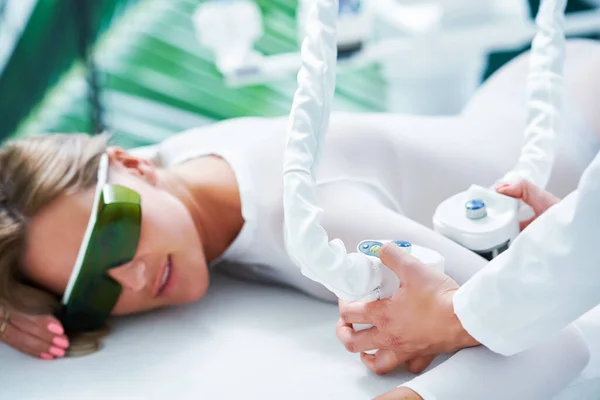
Precautions and Aftercare Tips for Hydrafacial in Summer
Hydrafacial treatments are popular for achieving glowing and rejuvenated skin. In summer, extra care is needed to protect and maintain skin health after a Hydrafacial. Here are essential precautions and aftercare tips to follow for the best results.
Importance of Wearing Broad-Spectrum Sunscreen with SPF 30+
After a Hydrafacial, your skin is more sensitive to UV rays. Applying a broad-spectrum sunscreen with SPF 30 or higher is crucial. This protects against both UVA and UVB rays.
Reapply sunscreen every two hours when outdoors. Sunscreens with zinc oxide or titanium dioxide provide excellent protection. These ingredients are gentle on the skin, especially after treatments like Hydrafacials.
Recommendations for Hats, Sunglasses, and Protective Clothing
Wearing a wide brimmed hat adds an extra layer of sun protection for your face. Opt for hats with a UPF rating for better coverage. Sunglasses with UV protection help shield the delicate eye area.
Protective clothing, such as long sleeves or sun-protective fabrics, is also recommended. Lightweight, breathable fabrics are best for staying cool while shielding the skin.
Hydration Tips: Drinking Water and Using Hydrating Skincare Products
Hydration is key after a Hydrafacial, especially in summer. Drink plenty of water to keep your skin hydrated from within. Aim for at least eight glasses a day.
Hydrating skincare products like hyaluronic acid serums help lock in moisture. Look for ingredients like glycerin, aloe vera, and ceramides. These components soothe the skin and maintain its natural moisture barrier.
Avoiding Harsh Skincare Ingredients Like Retinoids and Acids Post-Treatment
Your skin needs time to recover after a Hydrafacial. Avoid using retinoids, alpha hydroxy acids (AHAs), and beta hydroxy acids (BHAs) for a few days.
These ingredients can cause irritation and sensitivity. Stick to a gentle skincare routine with a mild cleanser and a soothing moisturizer. Products with calming ingredients like chamomile or green tea extract are beneficial.
Who Should Avoid Hydrafacials in Summer?
Hydrafacials are a popular skincare treatment, but they aren’t for everyone, especially in the summer. Certain individuals should avoid Hydrafacials during this time to prevent skin irritation or damage.
Individuals with Sensitive Skin Conditions
People with sensitive skin conditions like rosacea or eczema should avoid Hydrafacials in summer. This treatment involves exfoliation and suction, which can aggravate already inflamed or irritated skin.
For those with rosacea, the treatment may cause redness, flare ups, or discomfort. Similarly, individuals with eczema might experience increased dryness or sensitivity after the procedure. Consult with a dermatologist to find a more suitable skincare routine for sensitive skin types.
People with Recent Sunburns or Tanning
If you have a recent sunburn or have been tanning, it’s best to skip a Hydrafacial. The exfoliating process can further irritate sunburned skin, leading to peeling, discomfort, or prolonged recovery.
Tanned skin is also more sensitive and prone to pigmentation issues after treatments. Instead, focus on soothing and hydrating the skin to recover from sun exposure before considering any facial treatments.
Patients on Photosensitizing Medications or Treatments
Those on medications or treatments that increase photosensitivity should avoid Hydrafacials in summer. Medications like retinoids, certain antibiotics, and other skin treatments can make your skin more sensitive to light.
Combining these with a Hydrafacial could increase the risk of skin reactions, such as redness, pigmentation, or even burns. Always inform your skincare professional about any medications or topical treatments you’re using before undergoing any facial treatments.
General Guidelines for Hydrafacials in Summer
Hydrafacials can be beneficial but aren’t always the best choice in summer. People with delicate, sun-exposed, or medically treated skin need to be cautious.
Understanding your skin type and condition is crucial to avoid unwanted side effects. Consulting with a skincare professional will help you determine the safest and most effective treatments for your skin during the hot months.
Alternatives to Hydrafacials in Summer
Hydrafacials are popular, but there are other facial treatments that are great for summer with fewer side effects. While Hydrafacials provide deep hydration and exfoliation, some people prefer gentler options during hotter months. Here are a few summer-friendly facial treatments that can offer glowing skin with minimal irritation.
Microneedling (With Caution)
Microneedling is a treatment that uses tiny needles to create micro injuries on the skin’s surface. This process stimulates collagen production, improving skin texture and reducing fine lines.
However, it’s essential to approach microneedling cautiously in summer. Overexposure to the sun post-treatment can lead to irritation or hyperpigmentation. Always apply broad-spectrum sunscreen and follow aftercare instructions.
Benefits
Boosts collagen production.
Reduces acne scars and fine lines.
Enhances skin texture.
Potential Side Effects
Redness or minor swelling.
Risk of hyperpigmentation if not protected from the sun.
Possible infection if aftercare is neglected.
Gentle Enzyme Peels
Enzyme peels are a great alternative to chemical peels in the summer. They use natural enzymes from fruits like papaya and pineapple to exfoliate the skin gently.
These peels remove dead skin cells without causing significant irritation or sensitivity. Enzyme peels are ideal for achieving smoother, brighter skin without the downtime associated with stronger exfoliants.
Benefits
Gently exfoliates dead skin cells.
Suitable for sensitive skin.
Minimal risk of sun sensitivity.
Potential Side Effects
Mild tingling or redness.
Not as effective on deep wrinkles or scars.
Possible allergic reactions in sensitive individuals.
Oxygen Facials
Oxygen facials infuse oxygen and serums directly into the skin. This treatment hydrates, plumps, and revitalizes the skin, making it ideal for summer. Oxygen facials are non-invasive and have minimal downtime, providing an instant glow without the harsh effects of some other treatments.
Benefits
Hydrates and plumps the skin.
Enhances radiance and glow.
No downtime or irritation.
Potential Side Effects
Rare allergic reactions to serums.
Temporary redness in sensitive skin.
Results may be short-lived for some.
Choosing the Best Summer Facial Treatment
Choosing the right facial treatment in summer depends on your skin type and concerns. Hydrating facials, enzyme peels, and oxygen treatments offer effective alternatives to Hydrafacials.
They help achieve healthy, glowing skin without the risk of sun damage or irritation. Always consult a skincare professional to find the best option for your skin’s needs during the hot months.
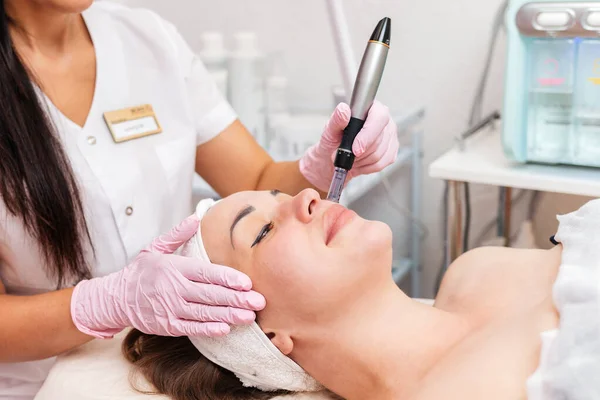
FAQs
What is a Hydrafacial, and how does it work?
A Hydrafacial is a non-invasive skin treatment that cleanses, exfoliates, extracts impurities, and hydrates the skin using a patented vortex technology. It uses a series of serums and gentle suction to remove dead skin cells, unclog pores, and infuse the skin with nourishing ingredients, leaving it refreshed and glowing.
Are there any specific side effects of a Hydrafacial in summer?
Yes, there can be some specific side effects of a Hydrafacial in summer. These may include increased sensitivity to sunlight, redness, and slight swelling due to the skin being more vulnerable to heat and UV rays post treatment. It is essential to apply sunscreen and avoid direct sun exposure to minimize these risks.
Can a Hydrafacial cause skin irritation in hot weather?
Yes, skin irritation is possible, especially in hot weather. The combination of heat, humidity, and post-treatment sensitivity may lead to redness, itchiness, or mild inflammation. Using gentle skincare products, staying hydrated, and avoiding excessive sun exposure can help reduce these symptoms.
How can I protect my skin after a Hydrafacial in the summer?
To protect your skin after a Hydrafacial in summer, you should apply a broad-spectrum sunscreen with SPF 30 or higher, wear protective clothing and a wide brimmed hat, avoid prolonged sun exposure, and stay in shaded areas. Keeping your skin hydrated with a gentle, non comedogenic moisturizer is also important.
Can Hydrafacial cause sunburn or tanning?
While a Hydrafacial itself does not cause sunburn or tanning, the procedure makes the skin more susceptible to UV damage. Therefore, it is crucial to apply sunscreen diligently and avoid direct sun exposure for at least 24-48 hours post-treatment to prevent sunburn or unwanted tanning.
Is it safe to get a Hydrafacial if I have sunburn or recently tanned skin?
It is not recommended to get a Hydrafacial if you have sunburned or recently tanned skin. The treatment can further irritate already sensitive or damaged skin, leading to increased redness, peeling, or discomfort. It is best to wait until your skin has fully healed before undergoing a Hydrafacial.
Can Hydrafacial exacerbate acne in hot and humid conditions?
Hydrafacials generally help reduce acne by deep cleansing the pores, but hot and humid conditions may cause excess sweating and oil production, potentially leading to breakouts. It is important to follow a good skincare regimen and avoid touching your face frequently to prevent clogging of pores after the treatment.
How often should I get a Hydrafacial in the summer?
In the summer, it is generally safe to get a Hydrafacial every 4-6 weeks, depending on your skin type and concerns. However, it is crucial to consult with your dermatologist or skincare specialist to determine the optimal frequency and ensure your skin’s health during the hotter months.
Can Hydrafacial cause pigmentation issues in summer?
Hydrafacial itself does not cause pigmentation issues, but post-treatment sun exposure can increase the risk of hyperpigmentation due to heightened skin sensitivity. Consistent use of sunscreen and avoidance of direct sunlight can prevent pigmentation problems after a Hydrafacial.
What should I avoid doing after a Hydrafacial in summer?
After a Hydrafacial in summer, avoid excessive sun exposure, hot showers, saunas, strenuous exercise, and using harsh skincare products like exfoliants or retinoids for at least 24-48 hours. This helps prevent irritation and allows the skin to heal properly.
Conclusion
In conclusion, while a HydraFacial is generally safe and effective for many skin types, it’s important to be mindful of potential side effects, especially in summer. Increased sun exposure, heat, and humidity can heighten the risk of irritation, redness, and sensitivity following the treatment.
To minimize these risks, ensure you follow proper aftercare, such as applying sunscreen, staying hydrated, and avoiding direct sunlight for a few days post treatment.
Consulting with a skincare professional can help tailor the procedure to your specific skin needs and ensure the best results with minimal side effects during the warmer months.
